![]()
Coins
![]()
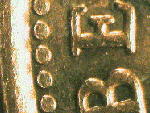 We all handle coins everyday and rarely give them a second
glance. But coins can be interesting to look at under a low power
stereo microscope or just a 10X hand lens. The detail can be
quite intricate and lighting at a low angle from say a desk spot
lamp can bring out the detail in sharp relief. The image on the
right (magnification 20X) is from a UK two pence coin.
We all handle coins everyday and rarely give them a second
glance. But coins can be interesting to look at under a low power
stereo microscope or just a 10X hand lens. The detail can be
quite intricate and lighting at a low angle from say a desk spot
lamp can bring out the detail in sharp relief. The image on the
right (magnification 20X) is from a UK two pence coin.
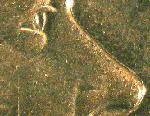 The image on the left (magnification
20X) is a close up of the face of Elizabeth II on the coin. If
you have some new and older coins the effect of wear and tear on
the coin's detail can be compared.
The image on the left (magnification
20X) is a close up of the face of Elizabeth II on the coin. If
you have some new and older coins the effect of wear and tear on
the coin's detail can be compared.
Mouldy oranges
![]()
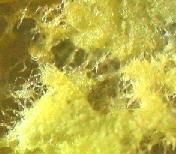 Fruit can be worth a closer look with a hand lens or stereo
microscope, particularly if mould is beginning to grow on the
skin. The orange shown right (magnification 32X) was developing a
white mould although it hadn't been left out for very long. The
air around us contains the tiny spores of moulds and it is not
long before fruit, bread or other uncovered foodstuffs in the
kitchen start to go mouldy.
Fruit can be worth a closer look with a hand lens or stereo
microscope, particularly if mould is beginning to grow on the
skin. The orange shown right (magnification 32X) was developing a
white mould although it hadn't been left out for very long. The
air around us contains the tiny spores of moulds and it is not
long before fruit, bread or other uncovered foodstuffs in the
kitchen start to go mouldy.
By eye the mould looks like white blotches on the fruit surface. But in close-up even at low magnification it can be seen that the mould consists of a dense mass of filaments called the mycelium. Mould commonly refers to one of a number of species of fungi that are associated with food spoilage and plant diseases.
The fungi is one of the
biological Kingdoms ie. major groups of living organisms, others
include plants, animals, protista (mainly algae and protozoa) and
bacteria. The fungi includes the mushrooms and toadstools and the
wide variety of micro-fungi that grow on crops and other plants
such as rusts, smuts, mildews etc.
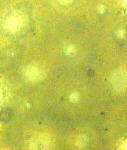 If peeling an orange, take a moment to examine the orange peel a
little more closely. Examined with a hand lens the peel shows the
oil glands (shown left, magnification 25X) which contain a
natural oil. The oil from orange peel is extracted commercially
to give 'oil of orange'. The oil glands are easier to see if a
very thin layer of the peel is removed with a knife (care!) and
examined under transmitted light either using a stereo or
compound microscope at low magnification.
If peeling an orange, take a moment to examine the orange peel a
little more closely. Examined with a hand lens the peel shows the
oil glands (shown left, magnification 25X) which contain a
natural oil. The oil from orange peel is extracted commercially
to give 'oil of orange'. The oil glands are easier to see if a
very thin layer of the peel is removed with a knife (care!) and
examined under transmitted light either using a stereo or
compound microscope at low magnification.
Further reading: Microsoft Encarta has good sections under
'mold', 'fungi' etc. Also see under 'citrus' for the oils found
in citrus fruits.
Wood-louse
![]()
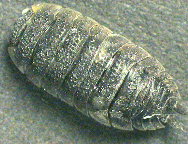 The wood-louse (or sow-bug) shown right (magnification 8X) is
often found in the home especially in the damper places such as
in the out-house, bathroom or kitchen. A related species that
curl up into a tight ball when disturbed are commonly called
pill-bugs. They look like miniature armadillos with their plated
backs. If you can't find one indoors you could try the garden or
greenhouse especially under stones, plant-pots etc.
The wood-louse (or sow-bug) shown right (magnification 8X) is
often found in the home especially in the damper places such as
in the out-house, bathroom or kitchen. A related species that
curl up into a tight ball when disturbed are commonly called
pill-bugs. They look like miniature armadillos with their plated
backs. If you can't find one indoors you could try the garden or
greenhouse especially under stones, plant-pots etc.
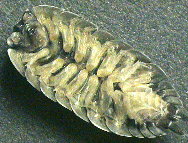 They are harmless creatures and in fact
perform the useful service of eating decaying vegetable matter,
although some may eat young plant shoots. The image left shows
the underside (magnification 8X), where the seven pairs of limbs
can be seen. The April 1997 Image of the Month also shows a nice image of the
underside of a wood louse.
They are harmless creatures and in fact
perform the useful service of eating decaying vegetable matter,
although some may eat young plant shoots. The image left shows
the underside (magnification 8X), where the seven pairs of limbs
can be seen. The April 1997 Image of the Month also shows a nice image of the
underside of a wood louse.
The wood-louse and pill-bug
both belong to the order Isopoda which is one of the orders in
the Phylum Crustacea. The Isopoda is a group of diverse animals
including those living on land, sea and freshwater. Most of these
organisms are typically less than 35mm in length but Bathynomus
giganteus is a marine species found in the Caribbean which
grows to 35 cm! Read an article on the water louse (Asellus) which is a member of
this order.
Further reading: The superb book 'The Natural History of the
Garden' by M Chinery (Fontana, London, 1978) has a good
section on the biology and life cycle of wood lice. Also
described and illustrated in Microsoft Encarta under
'crustacean'.
Flies - Fairy Flies one of the
smallest insects
![]()
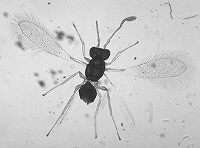 A
good supply of subjects for the microscope can usually be found
in spiders webs in the garage or on window sills. As well as the
larger flies, keep an eye out for very tiny flies because these
can be particularly fascinating.
A
good supply of subjects for the microscope can usually be found
in spiders webs in the garage or on window sills. As well as the
larger flies, keep an eye out for very tiny flies because these
can be particularly fascinating.
If you are lucky you may find the tiny fly called a fairy fly (shown right, magnification ca. 24X). The largest of these insects only has a wing span of 3mm, so you will have to look hard to find them. They have a strong claim to be one of the world's smallest insects, as the fairy fly Alaptus magnanimus is only 0.21mm long.
Although called flies, they are in fact tiny parasitic wasps (Family Myrmaridae) of the insect order Hymenoptera which includes bees and wasps. They lay their eggs in the eggs of other insects. Not surprisingly they are not strong flyers and they tend to be carried along on air currents and are carried into houses in Spring and Summer. Their paddle-shaped hairy wings are quite intriguing and unlike those of most flies.
Surprisingly little is known about fairy flies, and this is an insect group where the amateur naturalist could make a valuable contribution if they became familiar with the group, identified their local species and studied the ecology and behaviour of the fairy flies.
Further reading: Fairy Flies - A Topic for Study by H S
Henderson. Quekett Journal of Microscopy, 1987, vol. 35, part 8, p.645-646.
******************************
Welcome to this new bi-monthly series
which encourages you to explore in close-up the everyday things
around your home, garden and garage.
What do you need? - each subject covered in this series will have an icon to show what you will need to study an object.
![]() can be viewed with a 10X hand lens or
similar magnifying glass.
can be viewed with a 10X hand lens or
similar magnifying glass.
![]() use a low
power stereo microscope 10X-40X for a clearer look
use a low
power stereo microscope 10X-40X for a clearer look
![]() requires a compound microscope with
magnifications 30X up to 200X
requires a compound microscope with
magnifications 30X up to 200X
Who is the series designed for? We've tried to make it of interest to both the novice and more experienced microscopist. Each topic will have a brief description with images to illustrate the fascinating things you can find to look at. But there will be a click here prompt for many topics which will provide more background information and suggestions for further study.
This can be an exploratory journey together, because the author admits he rarely looks at everyday things under a microscope .... so why not join me to explore the fascinating world in close-up around your home! Return to top of page.